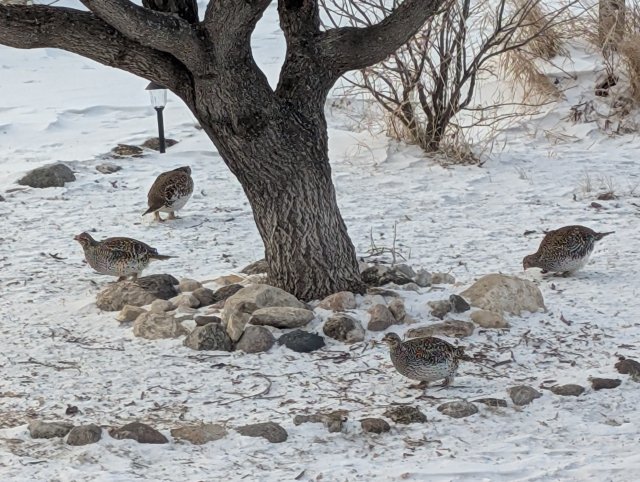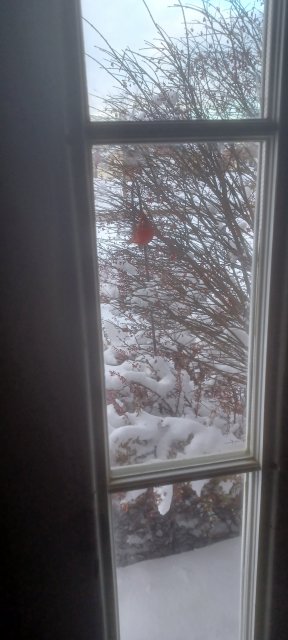I thought of this thread just now while sitting in the den and enjoying the small group of Sharptailed Grouse that are scratching through the snow beneath the bird feeders. These are a common bird here, but typically don't come right into the yard except in winter. Always nice to see.
But my happiness is tempered by the fact that the lumpers and spllitters are doing their thing again, and it has worked against me this time. While I don't follow the latest birding news very much, I have just discovered that the eggheads have decided that the Common Redpoll and the Hoary Redpoll are actually a single species, rather than the two distinct species they have always been considered to be. The Common is a bird that, in most winters, is visible every day at my feeders in large numbers. The Hoary, in contrast, is a rare bird indeed, and I might see only one or two...or 6....or none!...in any given winter. Both species are strictly winter birds for me, breeding far to the north and flying south to sunny Manitoba only during the cold season.
So, thanks to some nameless guy in a labcoat and Crocs toiling in the basement of a museum somewhere...at least that's how I envision these guys...my life list has grown shorter by one. Not that I intend to do anything about it...
At the same time, I thought I had a new local rarity to chase. A recent report alerted me to the presence of a Short-billed Gull not too far away; I felt my gluteus maximus tensing up in preparation to fling me out of my chair to go in search of it, and I was excited as I had never before heard of a Short-billed Gull. I figured it must be from so far away, likely Asian or even Australian, that I had never crossed paths with it, and I was pumped to see it.
But....it turns out that the Mew Gull (also called Common Gull) had been split into two species about 3 years ago. The Mew Gull with which I was familiar from the Canadian west coast was now its own species: Short-billled Gull. The birds which had previously been identified as Mew Gulls in Eurasia were now officially called Common Gull. Mew and Common Gull were a single species with a confusing name discrepancy up to that point. Now...there is no Mew Gull any longer, and I need some White-Out to correct my life list...which, believe it or not, is still handwritten on paper.
What a relief to learn that the brightest minds of our age are keeping track of important details like this...
But my happiness is tempered by the fact that the lumpers and spllitters are doing their thing again, and it has worked against me this time. While I don't follow the latest birding news very much, I have just discovered that the eggheads have decided that the Common Redpoll and the Hoary Redpoll are actually a single species, rather than the two distinct species they have always been considered to be. The Common is a bird that, in most winters, is visible every day at my feeders in large numbers. The Hoary, in contrast, is a rare bird indeed, and I might see only one or two...or 6....or none!...in any given winter. Both species are strictly winter birds for me, breeding far to the north and flying south to sunny Manitoba only during the cold season.
So, thanks to some nameless guy in a labcoat and Crocs toiling in the basement of a museum somewhere...at least that's how I envision these guys...my life list has grown shorter by one. Not that I intend to do anything about it...
At the same time, I thought I had a new local rarity to chase. A recent report alerted me to the presence of a Short-billed Gull not too far away; I felt my gluteus maximus tensing up in preparation to fling me out of my chair to go in search of it, and I was excited as I had never before heard of a Short-billed Gull. I figured it must be from so far away, likely Asian or even Australian, that I had never crossed paths with it, and I was pumped to see it.
But....it turns out that the Mew Gull (also called Common Gull) had been split into two species about 3 years ago. The Mew Gull with which I was familiar from the Canadian west coast was now its own species: Short-billled Gull. The birds which had previously been identified as Mew Gulls in Eurasia were now officially called Common Gull. Mew and Common Gull were a single species with a confusing name discrepancy up to that point. Now...there is no Mew Gull any longer, and I need some White-Out to correct my life list...which, believe it or not, is still handwritten on paper.
What a relief to learn that the brightest minds of our age are keeping track of important details like this...






